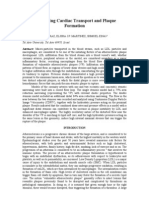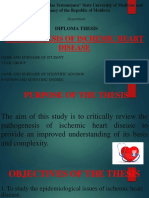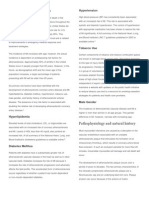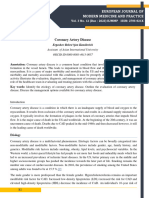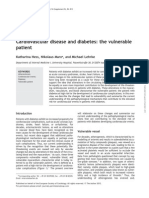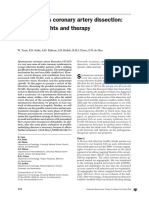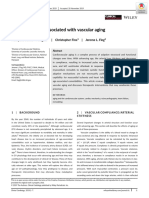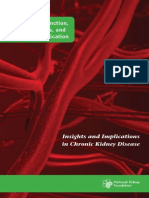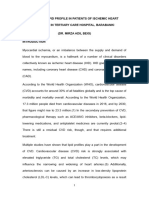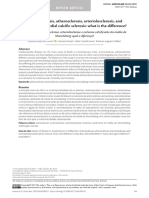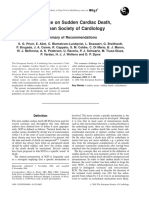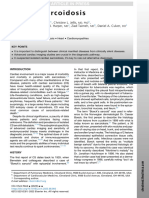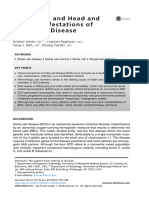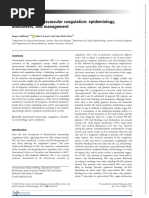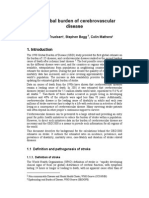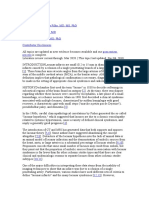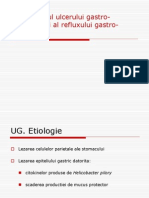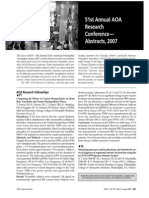The New Pathophysiology of Coronary
The New Pathophysiology of Coronary
Uploaded by
Sebastian RomeroCopyright:
Available Formats
The New Pathophysiology of Coronary
The New Pathophysiology of Coronary
Uploaded by
Sebastian RomeroCopyright
Available Formats
Share this document
Did you find this document useful?
Is this content inappropriate?
Copyright:
Available Formats
The New Pathophysiology of Coronary
The New Pathophysiology of Coronary
Uploaded by
Sebastian RomeroCopyright:
Available Formats
Coronary Artery Disease: New Insights into the Pathophysiology, Prevalence, and Early Detection of a Monster Menace
James Slater, MD and Velisar Rill, MD
Coronary artery disease (CAD) is the leading cause of morbidity and mortality in the United States and other industrialized countries. In the undeveloped world a similar epidemic is brewing. A new pathophysiologic paradigm has emerged, which assigns the mediators of inammation a much larger role in the disease process. This paradigm has helped explain the unpredictable nature of many adverse consequences of CAD. The long latent phase of the disease, and often sudden initial presentation, make efforts at early detection extremely important. Considerable work has been devoted to identify, as well as inuence, predisposing risk factors for developing arteriosclerosis. Novel markers of inammation, like C-reactive protein, have been identied and compared to traditional risk factors. In addition, new imaging modalities introduce the possibility of screening for subclinical disease. Electron beam and multidetector computed tomography (CT) scanners, as well as other techniques, are emerging as powerful tools to detect early disease presence and allow intervention to take place before major clinical events occur. Advances in our understanding of the pathophysiology of CAD, and our ability to image the stages of silent disease will go hand in hand to revolutionize our approach to prevention and treatment of this deadly malady. 2004 Elsevier Inc. All rights reserved.
EATH RATES from coronary artery disease (CAD) peaked in the United States in 1963 and have been declining since that time. The decline has leveled off in recent years, however, and overall has been less dramatic in women. In the developing nations, unfortunately, the burden of CAD is rapidly increasing, and ischemic heart disease is the leading cause of mortality worldwide. As the population of the industrialized world ages, the impact of CAD on morbidity and mortality is expected to increase, reducing the rate of decline of the last 40 years. During the last decade, there has been considerable advancement in our understanding of the pathophysiology of atherosclerosis as well as major developments in the treatment of the disease, based in part upon this new knowledge. The realization that primary prevention (treatment of individuals before there is a clinical manifestation of illness) effectively reduces the impact of the disease has made the value of early disease detection even more important.
EPIDEMIOLOGY
is similarly enormous, with a World Health Organization study suggesting that in 1998, 30.9% of all deaths and 10.3% of the total disease-related burden, calculated as disability adjusted life years lost, was the result of cardiovascular disease.3 In the coming decades, especially in developing countries, the impact of atherosclerotic disease is expected to greatly increase. This is partly due to the rapid increase in urbanization. In 1970, 36.6% of the worlds population lived in urban areas and this is expected to increase to 61.1% by 2025.4 Urbanization can be considered in some ways as a migration to a Western-style environment, where there is a decrease in daily energy expenditure, accompanied by increased consumption of energyrich foods. Many studies, most famously the NiHon-San study of Japanese immigrants, show that migration to more urban environments is associated with an increase in blood cholesterol levels and coronary heart disease rates.5-9 In industrial-
By almost every measure CAD takes a devastating toll on the health of many communities. In addition to being the leading cause of death, it is a major source of disability. Over one million Americans are expected to have a heart attack this year.1,2 The majority of these myocardial infarctions will occur in people over the age of 65, but over 300,000 individuals between the ages of 45 and 65 will also be stricken, fatally in many cases. World wide, the burden of cardiovascular disease
From Velisar Rill, MD, Fellow, Interventional Cardiology, New York University Medical Center, New York, NY. Address correspondence to: James Slater, MD, New York University Medical Center, 425 West 59th Street, New York, NY 10019;; e-mail: jslater@slrhc.org.; e-mail: velisar@gmx.de. Editors Note: This article was published in error in the April 2003 issue of Seminars in Ultraound, CT, and MRI, which was a neuroradiology issue. It is reprinted here, with minor changes, in conjunction with other articles that concern highresolution CT imaging. 2004 Elsevier Inc. All rights reserved. 0887-2171/04/2502-0004$30.00/0 doi:10.1053/j.sult.2003.11.003
113
Seminars in Ultrasound, CT, and MRI, Vol 25, No 2 (April), 2004: pp 113-121
114
SLATER AND VELISAR
ized countries we are also witnessing an explosion of obesity throughout the population, including children. School age children are developing type 2 diabetes because of early onset obesity, and the implications of these demographic developments for increasing risk of cardiovascular disease are quite frightening.10-12
PATHOPHYSIOLOGY
For the most part, coronary atherosclerosis is a diffuse disease affecting most segments of the coronary arteries. This was well documented by Roberts13 several decades ago when he showed at autopsy, in patients dying of myocardial infarction, 95% of coronary artery cross sections taken 5 mm apart were narrowed more than 25% by atherosclerotic plaque. Reliance on coronary angiography to visualize the disease, however, caused us to lose site of this observation. The typical diagnostic angiogram is perhaps more accurately described as a coronary lumenogram, mostly visualizing encroachment of disease into the lumen, but providing little indication of the plaque buildup in the vessel wall. Important observations by Glagov et al14 revealed that coronary arteries enlarge their external elastic membranes and expand their size to accommodate atherosclerotic plaque accumulation. This gives the angiographer the false impression that little plaque may exist because, despite extensive plaque buildup, the luminal diameter is preserved. At the Cleveland Clinic, angiographers were asked, in patients undergoing single vessel angioplasty, to pick the most normal portion of the coronary tree. When these sections were subsequently viewed with intracoronary ultrasound, which accurately visualizes the plaque burden in the vessel wall, the average cross-sectional area reduction of the region encircled by the external elastic membrane was around 40%. Thus, the overall burden of atherosclerotic disease in an individual patient is considerably underestimated by conventional coronary angiography. When ultrasound was used to visualize the coronary arteries of donor hearts for cardiac transplantation, all of which had normal coronary angiograms, 25% of hearts from donors under age 25 and 70% of hearts from donors over age 40 contained atherosclerotic plaque.15 This intramural accumulation of atherosclerosis, although not compromising coronary blood ow through narrowing the lumen, is far from benign.
For example, Ambrose et al16 and others17-19 have shown in patients who underwent angiograms several months prior to a myocardial infarction that the site of infarction in the coronary artery was previously narrowed by 50% in the vast majority of patients. These observations and subsequent work by many others has led to the concept of plaque rupture as the instigating event in both myocardial infarction and most acute coronary syndromes, such as unstable angina and non-ST elevation myocardial infarction.20,21 The implication of these observations is that a large percentage of clinical events in patients with CAD are unpredictable. The patient with chest pain on exertion who has a severe narrowing of a coronary artery easily treated with angioplasty usually does not suffer a deadly or disabling myocardial infarction if he or she is recognized and treated appropriately. It is the asymptomatic patient who ruptures a non-ow-limiting, largely intramural plaque, without any warning, who represents the greatest treatment challenge. Most unpredictable cardiovascular events, it is currently believed, arise from fracture of a brous cap that separates the lipid core in the wall of the coronary artery from the owing blood in the lumen. A large amount of scientic investigation has focused on the composition of this brous layer, which has been shown to be undergoing continuous remodeling.22 It has been postulated that a dynamic exists between synthetic and degradative processes in the vessel wall mediated by cytokines, which are secreted peptides and proteins that mediate local interactions between various cells. These molecules are involved in dynamic changes in arterial wall anatomy and plaque morphology, which are part of the long-term accommodation of the arterial lumen to the accumulation of lipids. Most cytokines are believed to be released by cells participating in inammatory reactions set in motion by the presence of lipid particles in the vessel wall. At sites where plaques have ruptured, causing fatal coronary thrombosis, there are typically fewer smooth muscle cells and a relatively thin brous cap.23 Recent work has shown that elastolytic cathepsins expressed in atheroma and regulated by inammatory mediators can weaken the protective brous cap.24 It has been known for many years that intramural plaque accumulation renders endothelial function abnormal and previously vasodilatory stimuli become
CORONARY ARTERY DISEASE
115
make those sections of the coronary anatomy, which are remodeling, most vulnerable to rupture and the onset of sudden, unpredictable coronary events. All of these recent pathophysiologic observations enhance the value of screening modalities, because unless we can detect subclinical disease, we will not be able to intervene until it is too late in a large percentage of patients whose presenting symptoms of CAD are sudden and unpredictable.
PREVENTION OF CORONARY ARTERY DISEASE
Fig 1. Direct comparison of magnitude of relative risk of future cardiovascular events associated with HSCRP (hsCRP), cholesterol levels, lipoprotein(a), and homocysteine among apparently healthy women. For consistency, relative risks and 95% condence interval are shown for individuals in the top versus bottom quartile for each factor (reprinted with permission from Circulation 103:1813-1818, 2001).
vasoconstrictor in nature. In addition, the normally protective endothelial cells begin to secrete prothrombotic tissue factor in response to inammatory mediators, which alters the balance unfavorably between normal blood ow and thrombosis.25 How important the inammatory reaction may be to the atherosclerotic milieu has been highlighted by Ridker and others,26-28 who have shown that measurement of C-reactive protein (CRP) is a powerful predictor of coronary events. This protein is made by the liver in response to inammation elsewhere in the body. Infection causes the levels to skyrocket to 1000-fold the normal value; but in the absence of obvious infection, baseline levels of CRP can also be quantitated and the bell-shaped curve described can be used to predict coronary events. As can be seen in Figure 1, the highest quartile (within the normal range) of CRP is associated with an increased number of coronary events even in people with low cholesterol. The combination of high cholesterol and high CRP is associated with the highest event level in most populations studied. Interestingly, recent work has shown CRP to be a more powerful independent predictor of adverse cardiac events (sudden death, myocardial infarction, and angina) than low density lipoprotein cholesterol (LDL-C).29 (Fig. 1). Thus, the mechanisms described above that allow coronary arteries to enlarge in response to intramural plaque accumulation, paradoxically, might also weaken the protective brous cover and
Prevention of disease has classically been divided between primary and secondary prevention. In the case of primary prevention, populations at risk who have as yet no manifestation of illness are treated, with a reduction in the eventual development of symptoms. In secondary prevention, patients, after an initial manifestation of the disease, are treated with a subsequent lowering of recurrent events. We will focus on the evidence that primary prevention of cardiovascular disease is effective, since it is in this population that screening modalities have the potential to be most effective. Risk factor identication and reduction remains the major clinical approach to the prevention of mortality and morbidity from CAD. Some risk factors are unalterable (age, family history, and gender), but others are susceptible to intervention with benecial results (dyslipidemias, tobacco, hypertension, obesity, physical inactivity, and diabetes). Some risk factors cluster together to produce a very high incidence of disease, as is the case for the metabolic syndrome characterized by insulin resistance with the risk factor combination of obesity, hypertension, dyslipidemia, and diabetes. Clinical trials for all of the modiable risk factors have shown (with the exception of rigorous type 2 diabetes control) that reduction in the magnitude or elimination of the risk factor results in decreased coronary artery event rates.30-33 Two trials of cholesterol reduction in largely asymptomatic individuals are illustrative of this concept. In the West of Scotland Coronary Prevention Study (WOSCOPS) 6595 men aged 45-64 years (mean LDL-C 192 mg/dL) were randomized to placebo or 40 mg/day pravastatin, a lipid-lowering agent of the statin class of drugs (HMG-CoA reductase inhibitors) for 4.9 years. On average, in those patients who received pravastatin, LDL cholesterol levels were reduced 26% and the incidence
116
SLATER AND VELISAR
of nonfatal myocardial infarction or cardiac death was signicantly reduced (31%) compared to the placebo group. Death alone was reduced 22%, but was of borderline statistical signicance (P 0.51).33 The Air Force/Texas Coronary Atherosclerosis Prevention Study (AFCAPS/TexCAPS) examined the effect of another statin (lovastatin) for up to 5.2 years in 6605 men and women with less elevated LDL cholesterol (150 mg/dL), but below average levels of the atheroprotective high density lipoprotein (HDL) cholesterol. In this trial a 25% reduction in LDL cholesterol levels resulted in a 37% relative decrease in major cardiac events.34 Thus, primary prevention in these populations resulted in improved clinical outcomes, perhaps by altering the lipid milieu in those portions of the coronary arteries containing soft, vulnerable plaques prone to rupture. In addition, aspirin and angiotensinconverting enzyme inhibitors (ACEs) have also been shown to reduce events in symptomatic, high risk people.35 Despite these advancements, our enthusiasm is tempered by the knowledge that approximately 50% of clinical events are still not explained by conventional risk factors.36 Furthermore, although the above-mentioned trials of primary prevention with lipid reduction show statistically signicant reductions of cardiac events, it is also clear that large numbers of patients are taking drugs for many years who in the absence of drug administration would probably never have a clinical episode of heart disease. In the WOSCOPS trial, for example, for every 1000 men given the drug, 50 coronary events (43 nonfatal) were prevented, which can also be interpreted as saying 950 men were treated for 5 years with no clear-cut clinical benet. This phenomenon of treating patients with 1 or more risk factors without understanding who actually is at risk was also demonstrated in a study of asymptomatic women over 55 published by Hecht and Superko.37 They divided women into those who had subclinical CAD by positive electron beam computed tomography (EBCT) and those who had zero coronary artery calcium scores. Interestingly, only age, but no other traditional risk factors, was different between the 2 groups. There was a trend toward higher total cholesterol scores in the EBCT-positive group, but it was not significant. They concluded that current guidelines for initiating cholesterol reduction therapy with statins
failed to target 47% of women who had evidence of subclinical CAD and mandated treatment of 38% of women in this cohort who had no evidence of subclinical CAD. The message of these studies is that we do not yet clearly know who is at risk of developing cardiac events and thus both undertreat and overtreat certain population groups in our attempts at primary prevention. It is also noteworthy that as many as 50% of people with 2 or more conventional risk factors are not being aggressively treated and a screening test that could demonstrate to these individuals that subclinical CAD exists might improve efforts at primary prevention.38 Since our knowledge of who will develop unpredictable and often fatal symptoms of CAD is imperfect, it would be valuable to have available methodologies to improve our assessment of individuals at risk. Screening tests, which establish the presence of subclinical disease, are attractive candidates for future advancements in risk assessment.
SCREENING FOR CORONARY ARTERY DISEASE
Screening for subclinical disease is, of course, a complex topic; but sufce it to say that efforts to identify individuals with subclinical CAD should ideally and eventually be directed to cost-effective discovery of latent disease whose later adverse manifestations can be effectively prevented. Criteria have been proposed for adoption of an effective screening procedure as well as deciding whether a community screening program provides more benets than harm.39,40 The ultimate demonstration of the utility of a screening test requires a randomized trial with half the population screened and standardized treatments initiated as a result of the screening followed by effective outcome assessment. Thus far no screening modality for the detection of CAD has been subjected to this approach. The next best criterion for demonstrating an effective screening procedure is to show that the new test predicts higher event rates than is possible using other available risk factors. We will try to review the available new imaging modalities for identifying subclinical CAD, although their current role compared to the traditional risk factor assessment remains untested and thus controversial.41
EXERCISE STRESS TESTING
Although not a new imaging modality, various types of exercise testing have been used to predict
CORONARY ARTERY DISEASE
117
individuals at risk for CAD events and are widely used in the so-called executive physical. When exercise testing has been used to screen individuals with multiple risk factors, an abnormal test has been associated with an increased odds ratio for the development of future clinical events.42,43 An abnormal exercise test has been shown to have a positive predictive value for the presence of obstructive CAD of 74% and aggressive risk factor reduction in a group of patients with positive exercise tests has been shown to result in a reduction of deaths from CAD compared to a usual care group.44 Since exercise testing mostly identies individuals with obstructive CAD (intraluminal), it is not known whether a modality that detects earlier, nonobstructive subclinical disease (intramural) will prove even more effective in preventing future events.
CORONARY CALCIUM DETECTION
The technical differences between EBCT and multislice computed tomography (MSCT) scanners is beyond the scope of this article, but both imaging modalities have been shown to be able to detect coronary calcication with considerably greater sensitivity than conventional uoroscopy.45 Since coronary calcication is almost always the result of atherosclerotic disease present in the vessel wall or lumen, the ability of these machines to detect subclinical CAD is potentially great.46 In general, numerous investigations have shown that a zero calcium score confers a very low risk of future cardiac events.41 Noncalcied atheroma can be missed by computed tomography, however, especially in younger people who are smokers. In addition, although high calcium scores are almost certainly associated with increasing amounts of vulnerable plaque, there is currently no existing possibility of recognizing, as a result of calcication, individual vulnerable lesions since many plaques remain uncalcied.47,48 Nonetheless, quantication of coronary artery calcium has been shown to be a reasonable measure of the atherosclerotic plaque burden when compared to pathologic, angiographic, or intravascular ultrasound assessment.49-51 Because coronary calcium accumulates exponentially in coronary arteries in an age-related fashion, it is important to adjust scores for both age and gender.52 For example, a calcium score of 100 in an 80-year-old male would have a different prognostic signicance than the same
score in a 40-year-old woman. Several studies have shown the ability of coronary calcium scores to predict future coronary events in asymptomatic patients. Arad et al49 showed that in 1172 asymptomatic individuals a calcium score 160 was associated with a statistically signicant (odds ratio 22) increase in the likelihood of having a combined endpoint of having a hard cardiac event (death or myocardial infarction) or undergoing coronary revascularization. Raggi and others54,55 likewise showed that categorization of the calcium scores by age- and sex-adjusted percentile rankings enabled prediction of a higher percentage of hard cardiac events in the patients in the highest quartile compared to patients in the other 3 quartiles, P 0.001. The latter study also suggested that higher percentile calcium scores were a stronger predictor of hard cardiac events than traditional risk factors although the condence intervals were wide because of small patient numbers. The criticism of these studies has been centered on the following 2 areas: (1) The inclusion of coronary revascularization events in the outcome analysis biases the studies in favor of increasing the predictive power of coronary calcium since the presence of calcium makes it more likely the patient will undergo further testing. And (2), the studies done to date have not included enough patients to accurately assess whether coronary calcium scores add to the information already available to the clinician in the form of traditional risk factors. The current literature provides conicting data in regard to the latter criticism. Arad et al53 demonstrated an increased odds ratio for prediction of a coronary event with EBCT compared to traditional coronary risk factors with an area under the receiver-operating curve (ROC) of 0.91, versus an area of 0.74 for the National Cholesterol Education Guidelines (NECP II). Detrano et al,56 however, showed similar ROC curves for EBCT and standard Framingham risk factor assessment and concluded that EBCT did not add incremental value in high risk subjects. The consensus statement from the American College of Cardiology and The American Heart Association concluded that the calcium score can predict risk of future cardiac events, but the incremental value over traditional multivariate risk-assessment models has not yet been determined.41 Most likely the greatest utility of coronary calcium screening in the asymptomatic individual will
118
SLATER AND VELISAR
be found in the patients at intermediate risk. The lowest and highest risk individuals will most likely be identied by traditional risk factors and treated cost effectively without added benet of coronary calcium scoring. Intermediate risk patients, however, may benet from CT detection of subclinical disease, which would allow more accurate assessment of individuals in need of expensive, and possibly lifelong, drug therapy. Three ongoing prospective trials, MESA, EDIC, and CARDIA II, involving a total of 13,200 patients, will hopefully provide more compelling data in the next several years with which we can more condently determine the added value of coronary calcium scoring.57 It should also be mentioned that coronary calcium scoring may also have a role in monitoring the progression of CAD, since several studies have shown that risk factor intervention has slowed the progression of calcium scores compared to no intervention and such serial analysis may provide reinforcement to both the physician and patient that treatment should be continued.58
NONINVASIVE CORONARY ANGIOGRAPHY WITH COMPUTED TOMOGRAPHY
found to be normal, a CT angiogram with a low calcium score and no visable disease in the major segments of the coronary tree could be quite useful and reassuring. The greatest advantage of CT angiography as a potential screening tool is its ability to simultaneously image disease in the lumen and the vessel wall. Early work is being done with these machines to investigate plaque composition by relating the Hounseld units to tissue density. It may be possible, for example, to distinguish soft, noncalcied, and potentially more vulnerable sections of the coronary tree from more brocalcic sections, which may further improve risk stratication. This technology is in its infancy; but with the rapid pace of advancement in imaging techniques, more exciting developments are likely to take place.
MAGNETIC RESONANCE CORONARY ANGIOGRAPHY
Improvements in CT scanner performance, patient preparation, and postprocessing algorhythms have combined to make noninvasive coronary imaging using both EBCT and MSCT more feasible. This technique, of course, requires the administration of intravenous contrast as well as increased patient preparation and postprocessing times, which, compared to calcium scoring alone, both increase slightly the risk as well as the cost of the procedure. Nevertheless, it is substantially simpler and safer than invasive coronary angiography. Improved gantry speeds, greater numbers of tomographic slices (12-16 and soon more), plus better image postprocessing have generated validation studies with 95% sensitivity and 86% specicity compared with conventional coronary angiography.59 The major accomplishment of the newer generation of multislice scanners, as reported recently by Nieman et al,60 is the reduction of nonevaluable studies to below 10%. Of course, the inferior spatial and temporal resolution of CT scanning compared to traditional angiography prevents visualization of smaller coronary arteries and in patients with heavy calcium burdens it is difcult to visualize the lumen; but since up to 30% of the coronary angiography studies currently done are
The ability of magnetic resonance angiography (MRA) to screen for CAD may be limited by the lengthy study time involved (average 70 minutes per patient), and inherent limitations in spatial resolution of the technique, which are dependent upon magnetic eld strength.61 Compared to the rapid acquisition times of CT angiography, the longer study times required by MRA introduce issues of respiratory artifacts that require additional adjustments by various gating techniques. A recent article by Kim et al,62 comparing MRA to conventional coronary angiography, showed that by restricting imaging to the proximal and mid portions of the coronary tree, 84% of these segments could be visualized by MRA. In these interpretable segments 78 of 93 clinically signicant stenoses could be identied by MRA (83% sensitivity). Although potentially useful for excluding patients with severe proximal CAD, MRA at present is probably not a useful method to screen for CAD. Nonetheless, the advantage represented by absence of ionizing radiation, coupled with advances in technique, which might allow 1 or 2 longer segments of the coronary tree to be targeted, may allow MRA to eventually assume a role in this arena.
CAROTID ULTRASOUND
Ultrasonographic assessment of the peripheral arteries, especially the carotid artery, is a sensitive tool for the detection of early atherosclerosis. Sev-
CORONARY ARTERY DISEASE
119
eral studies have shown increasing carotid intimamedia thickness and progression to overt carotid plaque to be associated with an increased prevalence of coexisting CAD.63 The advantage of this method of predicting the existence of CAD, of course, is that it is noninvasive, involves minimal time, and does not require radiation exposure. The disadvantages are that the coronary artery bed is not being directly examined and the incremental value of these studies, compared to traditional risk factors, has not been established.
SUMMARY
The need for improved methods to screen for CAD is well recognized, since traditional risk factor analysis only predicts roughly 50% of the patients who will develop manifestations of the most lethal chronic disease process affecting our population. Traditional risk factor analysis casts a wide net that, at least in certain subgroups, mandates treatment for many people who will never
develop disease and does not recognize other populations at risk. Newer imaging techniques offer the ability to potentially rene the identication of vulnerable individuals at a younger age and allow a more cost-effective strategy of primary prevention to emerge. We must use these techniques at present without the benet of large prospective population-based studies to compare their incremental value vis-a-vis conventional risk factor ` analysis, but as always, technological advances in medicine precede evidence-based utility. At the current time new coronary imaging techniques to identify subclinical CAD are probably best directed, in a cost-effective manner, to rening treatment patterns for individuals at intermediate risk of developing symptoms of coronary heart disease. Further research, however, will better dene their ultimate value and possibly lead to revolutionary breakthroughs in our ability to image and more effectively treat this important disease.
REFERENCES
1. American Heart Association: 2001 Heart and Stroke Statistical Update. Dallas, TX, American Heart Association, 2000 2. The World Health Report: Making a Difference. Geneva, World Health Organization, 1999 3. Yusuf S, Reddy S, Ounpuu S, et al: Global Burden of Cardiovascular Diseases Part I. Circulation 104:2746-2753, 2001 4. Reddy KS: The emerging epidemic of cardiovascular disease in India, in Shetty P, Gopalan C (eds): Diet, Nutrition and Chronic Disease: An Asian Perspective. Bedford, UK, Smith-Gordon, 1998, pp 50-54 5. Sheth T, Nair C, Nargundkar M, et al: Cardiovascular and cancer mortality among Canadians of European, south Asian and Chinese origin from 1979 to 1993: An analysis of 1.2 million deaths. CMAJ 161:132-138, 1999 6. Anand SS, Yusuf S, Vuksan V, et al: Differences in risk factors, atherosclerosis, and cardiovascular disease between ethnic groups in Canada: The Study of Health Assessment and Risk in Ethnic Groups. Lancet 356:279-284, 2000 7. Zhou B: Diet and cardiovascular disease in China, in Shetty P, Gopalan C, (eds): Diet, Nutrition and Chronic Disease: An Asian Perspective. Smith-Gordon, Bedford, UK, 1998, pp 26 30 8. Kagan A, Harris BR, Winkelstein Jr W, et al: Epidemiologic studies of coronary heart disease and stroke in Japanese men living in Japan, Hawaii and California: Demographic, physical, dietary and biochemical characteristics. J Chronic Dis 27:345-364, 1974 9. Koplan JP, Dietz Wh: Caloric imbalance and public health policy. JAMA 282:1579-1581, 2001 10. Marquis C: Americans need a better diet, new health study reports: New York Times, May 28, 2000, National Desk 11. Mokdad AH, Bowan BA, Ford ES, et al: The continuing epidemiology of obesity and diabetes in the United States, 1991-1998. JAMA 286:1995-1200, 2001 12. Mokdad AH, Ford ES, Bowman BA, et al: Prevalence of Obesity, Diabetes, and Obesity-Related Health Risk Factors, 2001. JAMA 289:76-79, 2003 13. Roberts WC: Diffuse extent of coronary atherosclerosis in fatal coronary artery disease. Am J Cardiol 20(65):2F-6F, 1990 14. Glagov S, Bassiouny HS, Giddens DP, et al: Compensatory enlargement of human atherosclerotic coronary arteries. N Engl J Med 316:1371-1375, 1987 15. Nissen SE: Who is at risk for atherosclerotic disease? Lessons from intravascular ultrasound. Am J Med 112(Suppl 8A):27S-33S, 2002 16. Ambrose JA, Winters S, Arora R, et al: Coronary angiographic morphology in myocardial infarction: A link between the pathogenesis of unstable angina and myocardial infarction. J Am Coll Cardiol 6:1233-1238, 1985 17. Little WC, Constantinescu M, Applegate RJ, et al: Can coronary angiography predict the site of a subsequent myocardial infarction in patients with mild-to-moderate coronary artery disease? Circulation 78:1157-1166, 1988 18. Ambrose JA, Winters SL, Arora RR, et al: Angiographic evolution of coronary artery morphology in unstable angina. J Am Coll Cardiol 7:472-478, 1986 19. Falk E, Shah PK, Fuster V: Coronary plaque disruption. Circulation 92:657-671, 1995 20. Davies MJ: Stability and instability: The two faces of coronary atherosclerosis. The Paul Dudley White Lecture, 1995. Circulation 94:2013-2020, 1996
120
SLATER AND VELISAR
21. Libby P: The molecular basis of the acute coronary syndromes. Circulation 91:2844-2850, 1995 22. Davies MJ, Richardson PD, Woolf N, et al: Risk of thrombosis in human atherosclerotic plaques: Role of intracellular lipid, macrophage, and smooth muscle cell content. Br Heart J 69:377-381, 1993 23. van der Wal AC, Becker AE, van der Loos CM, et al: Site of intimal rupture or erosion of thrombosed coronary atherosclerotic plaques is characterized by an inammatory process irrespective of the dominant plaque morphology. Circulation 89:36-44, 1994 24. Sukhova GK, Shi GP, Simon DI, et al: Expression of the elastolytic cathepsins S and K in human atheroma and regulation of their production in smooth muscle cells. J Clin Invest 102:576-583, 1998 25. Bevilacqua MP, Pober JS, Wheeler ME, et al: Interleukin 1: Activation of vascular endothelium effects on procoagulant activity and leukocyte adhesion. Am J Pathol 121:393-403, 1985 26. Ridker PM, Cushman M, Stampfer MJ, et al: Inammation, aspirin, and the risk of cardiovascular disease in apparently healthy men. N Engl J Med 336:973-979, 1997 27. Libby P, Ridker PM: Novel inammatory markers of coronary risk: Theory versus practice. Circulation 100:11481150, 1999 28. Ridker PM, Rifai N, Cleareld M, et al: for the Air Force/Texas Coronary Atherosclerosis Prevention Study Investigators: Measurement of the C-reactive protein for the targeting of statin therapy in the primary prevention of acute coronary events. N Engl J Med 344:1959-1965, 2001 29. Ridker PM: High-sensitivity C-reactive protein. Potential adjunct for global risk assessment in the primary prevention of cardiovascular disease. Circulation 103:1813-1818, 2001 30. Group SCR: Prevention of stroke by antihypertensive drug treatment in older persons with isolated systolic hypertension: Final results of the Systolic Hypertension in the Elderly Program (SHEP). SHEP Cooperative Research Group. JAMA 265:3255-3264, 1991 31. UK Prospective Diabetes Study Group: Efcacy of atenolol and captopril in reducing risk of macrovascular and microvascular complications of type 2 diabetes: UKPDS 39. BMJ 31:713-720, 317 32. Rubins HB, Robins SJ, Collins D, et al: Gembrozil for the secondary prevention of coronary heart disease in men with low levels of high-density lipoprotein cholesterol. Veterans Affairs High-Density Lipoprotein Cholesterol Intervention Trial Study Group. N Engl J Med 341:410-418, 1999 33. West of Scotland Coronary Prevention Study Group: Inuence of pravastatin and plasma lipids on clinical events in the West of Scotland Coronary Prevention Study (WOSCOPS). Circulation 97:1440-1445, 1998 34. Downs JR, Cleareld M, Weis S, et al: for the AFCAPS/ TexCAPS Research Group: Primary prevention of acute coronary events with lovastatin in men and women with average cholesterol levels: Results of AFCAPS/TexCAPS. JAMA 279: 1615-1622, 1998 35. Yusuf S, Sleight P, Pogue J, et al: Effects of an angiotensin-converting-enzyme inhibitor, ramipril, on cardiovascular events in high-risk patients. The Heart Outcomes Prevention Evaluation Study Investigators. N Engl J Med 342:145-153, 2000
36. Braunwald E: Shattuck Lecture. Cardiovascular medicine at the turn of the millennium: Triumphs, concerns and opportunities. N Engl Med J 337:1360-1369, 1997 37. Hecht HS, Superko HR: Electron beam tomography and National Cholesterol Education Program guidelines in asymptomatic women. J Am Coll Cardiol 37:1506-1511, 2001 38. Pearson A, Laurora I, Chu H, et al: The lipid treatment assessment project (L-TAP). Arch Intern Med 160:459-467, 2000 39. Thelle D: Prevention of cardiovascular diseases: A scientic dilemma. Scand Cardiovasc J 34:103-105, 2000 40. Rose G: The Strategy of Preventive Medicine. New York, NY: Oxford University Press; 1992 41. ORourke, Brundage B, Froelicher V, et al: ACC/AHA expert consensus document on electron-beam computed tomography for the diagnosis and prognosis of coronary artery disease. J Am Coll Cardiol 36:326-340, 2000 42. Gibbons LW, Mitchell TL, Wei M, et al: Maximal exercise test as a predictor of risk for mortality from coronary heart disease in asymptomatic men. Am J Cardiol 86:53-58, 2000 43. Gianrossi R, Detrano R, Mulvihill D, et al: Exerciseinduced ST segment depression in the diagnosis of multivessel coronary disease: A meta analysis. J Am Coll Cardiol 80:87-98, 1989 44. Okin PM, Prineas RJ, Grandits G, et al: Heart rate adjustment of exercise-induced ST-segment depression identies men who benet from a risk factor reduction program. Circulation 96:2899-2904, 1997 45. Wexler L, Brundage B, Crouse J, et al: Coronary artery calcication: Pathophysiology, epidemiology, imaging methods, and clinical implications. A statement for health professionals from the American Heart Association. Writing Group. Circulation 94:1175-1192, 1996 46. Stary HC, Chandler AB, Dinsmore RE, et al: A denition of advanced types of atherosclerotic lesions and a histological classication of atherosclerosis: A report from the Committee on Vascular Lesions of the Council on Arteriosclerosis, American Heart Association. Circulation 92:1355-1374, 1995 47. Schmermund A, Baumgart D, Gorge G, et al: Coronary artery calcium in acute coronary syndromes. A comparative study of electron-beam computed tomography, coronary angiography, and intracoronary ultrasound in survivors of acute myocardial infarction and unstable angina. Circulation 96: 1461-1469, 1997 48. Mann JM, Davies MJ: Vulnerable plaque. Relation of characteristics to degree of stenosis in human coronary arteries. Circulation 94:928-931, 1996 49. Arad Y, Spadaro LA, Goodman K, et al: Prediction of coronary events with electron beam computed tomography. J Am Coll Cardiol 36:1253-1260, 2000 50. Sangiorgi G, Rumberger JA, Severson A, et al: Arterial calcication and not lumen stenosis is highly correlated with atherosclerotic plaque burden in humans: A histologic study of 723 coronary artery segments using non-decalcifying methodology: electron beam computed tomography and coronary artery disease: Scanning for coronary artery calcication. J Am Coll Cardiol 31:126-133, 1998 51. Rumberger JA, Sheedy PF, Breen JF, et al: EBCT coronary calcium score cutpoints and associated angiographic lumen stenosis. J Am Coll Cardiol 29:1542-1548, 1997
CORONARY ARTERY DISEASE
121
52. Hoff JA, Chomka EV, Krainik AJ, et al: Age and gender distributions of coronary artery calcium detected by electron beam tomography in 35,246 adults. Am J Cardiol 87:13351339, 2001 53. Arad Y, Spadaro LA, Goodman K, et al: Predictive value of electron beam computed tomography of the coronary arteries: 19-month follow-up of 1173 asymptomatic subjects. Circulation 93:1951-1953, 1996 54. Raggi P, Callister TC, Cooil B, et al: Identications of patients at increased risk of rst unheralded acute myocardial infarction by electron-beam computed tomography. Circulation 101:850-855, 2000 55. Wahys R, Zellinger A, Raggi P: High coronary artery scores pose an extremely elevated risk for hard events. J Am Coll Cardiol 39:225-230, 2002 56. Detrano RC, Wong ND, Doherty TM, et al: Coronary calcium does not accurately predict near-term future coronary events in high-risk adults. Circulation 99:2633-2638, 1999 57. Behrenbeck TR, Gerber TC, Mohlenkamp S, et al: Economic aspects of using electron beam computerized tomography. Z Kardiol Suppl 1:43-49, 2000 58. Callister TQ, Raggi P, Cooil B, et al: Effect of HMG-
CoA reductase inhibitors on coronary artery disease as assessed by electron-beam computed tomography. N Engl J Med 339: 1972-1978, 1998 59. Rensing BJ, Bongaerts AH, van Geuns RJ, et al: Intravenous coronary angiography using electron beam computed tomography. Prog Cardiovasc Dis 42:139-148, 1999 60. Nieman K, Cademartiri F, Lemos P, et al: Reliable noninvasive coronary angiography with fast submillimeter multislice spiral computed tomography. Circulation 106:20512054, 2002 61. de Feyter PJ, Nieman K, van Ooijen, et al: Non-invasive coronary artery imaging with electron beam computed tomography and magnetic resonance imaging. Heart 84:442-448, 2000 62. Kim WY, Danias PG, Stuber M, et al: Coronary magnetic resonance angiography for the detection of coronary stenosis. N Engl J Med 345:1863-1869, 2001 63. Chambless LE, Heiss G, Folsom AR, et al: Association of coronary heart disease incidence with carotid arterial wall thickness and major risk factors: The Atherosclerosis Risk in Communities (ARIC) study, 1987-1993. Am J Epidemiol 146: 483-494, 1997
You might also like
- Annals NY AcademyDocument11 pagesAnnals NY AcademyzeevaronNo ratings yet
- ManuscriptDocument43 pagesManuscriptdanielfaria8No ratings yet
- Yatsynovich 2017 Cardiac SarcoidosiDocument64 pagesYatsynovich 2017 Cardiac SarcoidosiJohan ArocaNo ratings yet
- Pathogenesis of Ischemic Heart Disease: Diploma ThesisDocument24 pagesPathogenesis of Ischemic Heart Disease: Diploma ThesisEcaterina GorganNo ratings yet
- CID Coagulación Intravascular TratamientoDocument16 pagesCID Coagulación Intravascular Tratamientoaraceli garciaNo ratings yet
- Prevalence and Risk Factors: HypertensionDocument2 pagesPrevalence and Risk Factors: HypertensionKhristine Anne FabayNo ratings yet
- Coronary Artery Disease Literature ReviewDocument4 pagesCoronary Artery Disease Literature Reviewaflsvwoeu100% (1)
- Coronary Artery Disease: Assistant of Asian International University ORCID ID 0000-0003-4613-0057Document7 pagesCoronary Artery Disease: Assistant of Asian International University ORCID ID 0000-0003-4613-0057Putri WibowoNo ratings yet
- At Eros Cle RozaDocument12 pagesAt Eros Cle RozaAdina VarzaruNo ratings yet
- Acute Myocardial InfarctionDocument17 pagesAcute Myocardial InfarctionRuqowiyah TanjungNo ratings yet
- Vascular Odyssey: Navigating Arterial Insufficiency from Genes to CommunitiesFrom EverandVascular Odyssey: Navigating Arterial Insufficiency from Genes to CommunitiesNo ratings yet
- Comprehensive Insights into Acute Arterial Occlusion: Pathways, Prevention, and Holistic CareFrom EverandComprehensive Insights into Acute Arterial Occlusion: Pathways, Prevention, and Holistic CareNo ratings yet
- Cardiovascular Disease and Diabetes: The Vulnerable Patient: Katharina Hess, Nikolaus Marx, and Michael LehrkeDocument10 pagesCardiovascular Disease and Diabetes: The Vulnerable Patient: Katharina Hess, Nikolaus Marx, and Michael Lehrkekrungi21No ratings yet
- AtheroesclerosisDocument18 pagesAtheroesclerosisGabriel IdkNo ratings yet
- Carcinoid Heart Disease Case and Literature ReviewDocument6 pagesCarcinoid Heart Disease Case and Literature Reviewfihynakalej2No ratings yet
- Pathophysiology of Native Coronary, Vein Graft, and In-Stent Atherosclerosis PDFDocument20 pagesPathophysiology of Native Coronary, Vein Graft, and In-Stent Atherosclerosis PDFJorge Arturo Bustos MartinezNo ratings yet
- Cardiovascular Disease PHD ThesisDocument6 pagesCardiovascular Disease PHD Thesisafknawjof100% (2)
- Subarachnoid HemorrhageDocument21 pagesSubarachnoid HemorrhageArvind SeecharanNo ratings yet
- Spondilita Ankilozanta Cardio PulmonarDocument6 pagesSpondilita Ankilozanta Cardio PulmonarGiulia LungulescuNo ratings yet
- Management of Deep Vein Thrombosis and Pulmonary Embolism - CirculationDocument119 pagesManagement of Deep Vein Thrombosis and Pulmonary Embolism - CirculationIndah SherbinaaNo ratings yet
- Primer: AtherosclerosisDocument18 pagesPrimer: AtherosclerosisLeonardoCampanelliNo ratings yet
- Time Trends in The Prevalence of Atherosclerosis: A Population-Based Autopsy Study in March 2011Document5 pagesTime Trends in The Prevalence of Atherosclerosis: A Population-Based Autopsy Study in March 2011iamjenivicNo ratings yet
- Pharmacokinetics and PharmacodynamicsDocument166 pagesPharmacokinetics and PharmacodynamicsEvgeny BadmaevNo ratings yet
- Aortic Coarctation: Unraveling Pathways, Bridging Gaps, and Shaping the Future of Cardiovascular CareFrom EverandAortic Coarctation: Unraveling Pathways, Bridging Gaps, and Shaping the Future of Cardiovascular CareNo ratings yet
- Spon Artery DissceDocument6 pagesSpon Artery DissceMuhammad JunaidNo ratings yet
- Coronary Artery AtherosclerosisDocument21 pagesCoronary Artery AtherosclerosisfikriadityaNo ratings yet
- ASH Agenda Brochure 0221Document24 pagesASH Agenda Brochure 0221Kudo SinichiNo ratings yet
- Cardiac Involvement in Systemic SclerosisDocument7 pagesCardiac Involvement in Systemic SclerosisWisnu MataramNo ratings yet
- Atherosclerosis Unveiled: Navigating the Arterial Landscape from Genesis to ResilienceFrom EverandAtherosclerosis Unveiled: Navigating the Arterial Landscape from Genesis to ResilienceNo ratings yet
- Cardiac Changes Associated With Vascular Aging: Narayana Sarma V. Singam - Christopher Fine - Jerome L. FlegDocument7 pagesCardiac Changes Associated With Vascular Aging: Narayana Sarma V. Singam - Christopher Fine - Jerome L. Flegabraham rumayaraNo ratings yet
- Angio Displa SiaDocument4 pagesAngio Displa SiaBelaFawziaNo ratings yet
- Disfunctii Vaculare, Ateroscleroza Si Calcificari VasculareDocument24 pagesDisfunctii Vaculare, Ateroscleroza Si Calcificari VasculareMikaela W. Marcu100% (1)
- Lipid Profile in Ischaemic Heart Disease.Document48 pagesLipid Profile in Ischaemic Heart Disease.nikhilrathiand24No ratings yet
- HPC Art 33118-10Document25 pagesHPC Art 33118-10Bartek SmelaNo ratings yet
- The New Pathophysiology of Coronary Artery Disease: William P. CastelliDocument6 pagesThe New Pathophysiology of Coronary Artery Disease: William P. CastelliLeo AramburuNo ratings yet
- DownloadDocument8 pagesDownloadnoakucantikNo ratings yet
- Surgical Management of Coronary Artery DiseaseDocument41 pagesSurgical Management of Coronary Artery Diseasetarmohamed.muradNo ratings yet
- Cholesterol Crystal Embolism and Chronic Kidney DiDocument12 pagesCholesterol Crystal Embolism and Chronic Kidney DiKhairunnisa NsNo ratings yet
- Managementul Pacientilor Boala Arteriala PerifericaDocument5 pagesManagementul Pacientilor Boala Arteriala PerifericaIrina NeamtuNo ratings yet
- Aortic Coarctation Cardiology Clinics 2020Document15 pagesAortic Coarctation Cardiology Clinics 2020Angela OrozcoNo ratings yet
- Task Force On Sudden Cardiac Death, European Society of CardiologyDocument16 pagesTask Force On Sudden Cardiac Death, European Society of Cardiologyvasarhely imolaNo ratings yet
- Sarcoidosis CardíacaDocument14 pagesSarcoidosis Cardíacaluiserikolivares1390No ratings yet
- Neurological and Head and Neck Menifestations of Sickle Cell DiseaseDocument20 pagesNeurological and Head and Neck Menifestations of Sickle Cell Disease1.thekey.1No ratings yet
- Original Aortic Thrombosis and Thromboembolism in Young WomenDocument16 pagesOriginal Aortic Thrombosis and Thromboembolism in Young WomenbennparkerNo ratings yet
- 48 Cardiovascular Involvement inDocument5 pages48 Cardiovascular Involvement inchandanNo ratings yet
- Pathophysiology and Treatment of Hypertrophic CardiomyopathyDocument29 pagesPathophysiology and Treatment of Hypertrophic CardiomyopathyAdrin Ma'rufNo ratings yet
- Cardiovascular DiseaseDocument3 pagesCardiovascular Diseasearif wicaksonoNo ratings yet
- The Vascular Biology of Atherosclerosis and Imaging TargetsDocument6 pagesThe Vascular Biology of Atherosclerosis and Imaging TargetsOrsid Sierra OchoaNo ratings yet
- BR J Haematol 2021 Adelborg Disseminated Intravascular CoagulationDocument16 pagesBR J Haematol 2021 Adelborg Disseminated Intravascular CoagulationSergio Alberto Sulub NavarreteNo ratings yet
- Bod - Cerebrovascular Disease Stroke BurdenDocument67 pagesBod - Cerebrovascular Disease Stroke BurdenderiNo ratings yet
- Arrhythmia in Cardiac SarcoidosisDocument12 pagesArrhythmia in Cardiac SarcoidosisBinod KumarNo ratings yet
- The Dutch Vascular Factors in Dementia Study: Rationale and DesignDocument8 pagesThe Dutch Vascular Factors in Dementia Study: Rationale and DesignAraceli EnríquezNo ratings yet
- Journal Coronary Heart DiseaseDocument9 pagesJournal Coronary Heart DiseaseYuliyanti AhmadNo ratings yet
- Peripheral Artery DiseaseDocument6 pagesPeripheral Artery DiseaseArunDevaNo ratings yet
- Atherosclerosis: Incidence and Risk Factors. Currently in The United StatesDocument2 pagesAtherosclerosis: Incidence and Risk Factors. Currently in The United StatesIbraheem SairiNo ratings yet
- Anticoagulation in Patients With Kidney Failure OnDocument9 pagesAnticoagulation in Patients With Kidney Failure Onromany barsoomNo ratings yet
- Ultrasound Imaging For Risk Assessment in Atherosclerosis - PMCDocument21 pagesUltrasound Imaging For Risk Assessment in Atherosclerosis - PMCVivi YuliantiNo ratings yet
- PIIS246802492301536XDocument13 pagesPIIS246802492301536XjosedegibesNo ratings yet
- Cardiogenic ShockDocument9 pagesCardiogenic ShockrbaezaNo ratings yet
- Lacunar InfarctsDocument14 pagesLacunar InfarctsIRENA GENINo ratings yet
- Michael G. Newman Henry Takei Perry R. Klokkevold Fermin A. Carranza Newman and Carranzas Clinical Periodontology Saunders 2018 3847 3964Document118 pagesMichael G. Newman Henry Takei Perry R. Klokkevold Fermin A. Carranza Newman and Carranzas Clinical Periodontology Saunders 2018 3847 3964Iulia CîrciuNo ratings yet
- GMP Haccp CCPDocument66 pagesGMP Haccp CCPmanishpandey1972No ratings yet
- Aerosol Therapy (Nebulization)Document14 pagesAerosol Therapy (Nebulization)Jan Oliver YaresNo ratings yet
- Advanced ECG AnalysisDocument90 pagesAdvanced ECG AnalysisnursewinstonNo ratings yet
- Methods of Application of WaxDocument2 pagesMethods of Application of WaxYahia Tawfeek Alkilany100% (1)
- Personality Disorder 1: SeriesDocument10 pagesPersonality Disorder 1: SeriesYasser AlghrafyNo ratings yet
- Medicatia Ulcer GastricDocument26 pagesMedicatia Ulcer GastricNatalia MelnicNo ratings yet
- Colon CancerDocument4 pagesColon CancerbmxengineerNo ratings yet
- (Tailieudieuky.com) Hướng Dẫn Ôn Tập Và Làm Bài Thi Môn Tiếng Anh Vĩnh BáDocument362 pages(Tailieudieuky.com) Hướng Dẫn Ôn Tập Và Làm Bài Thi Môn Tiếng Anh Vĩnh BáLe HoangNo ratings yet
- Dip 2Document129 pagesDip 2Raju Teach KapsNo ratings yet
- NHS Scotland FactsheetDocument5 pagesNHS Scotland Factsheetjaredc_47No ratings yet
- Name: Seema Panchal: Topic: Comparison Between Classical Conditioning and Operant ConditioningDocument13 pagesName: Seema Panchal: Topic: Comparison Between Classical Conditioning and Operant ConditioningSACHIN PANCHALNo ratings yet
- Common Prescribed DrugsDocument33 pagesCommon Prescribed DrugsGlessica You50% (4)
- Conjunctivita - PPT (Lb. Engleza)Document107 pagesConjunctivita - PPT (Lb. Engleza)Ciubotaru CristiNo ratings yet
- Criteria 4 Proficient 3 Approaching Proficiency 2 Developing 1 Beginning Rating ProcedureDocument2 pagesCriteria 4 Proficient 3 Approaching Proficiency 2 Developing 1 Beginning Rating ProcedureJhan Veaver Lee MarquezNo ratings yet
- Case StudyDocument16 pagesCase StudyRitika goelNo ratings yet
- WARFARIN Prescribing Guidelines For The Management of Patients On Anticoagulant Therapy WIRRAL NHSDocument14 pagesWARFARIN Prescribing Guidelines For The Management of Patients On Anticoagulant Therapy WIRRAL NHSNavojit ChowdhuryNo ratings yet
- PCS HMCG - Docx CS - Docx 2ndDocument1 pagePCS HMCG - Docx CS - Docx 2ndJane Imperial LitcherNo ratings yet
- Materia Medica in Questions and Answers N Ramalingeswara Rao.06125 - 1lycopodium PDFDocument8 pagesMateria Medica in Questions and Answers N Ramalingeswara Rao.06125 - 1lycopodium PDFSenthil SubramanianNo ratings yet
- The Five-Aggregate Model of The Mind, by Nandini D. KarunamuniDocument7 pagesThe Five-Aggregate Model of The Mind, by Nandini D. KarunamuniLeopoldo ArtilesNo ratings yet
- Prenatal Yoga Flyer-Full PageDocument1 pagePrenatal Yoga Flyer-Full PagejaclynrevisNo ratings yet
- 1recent ExamsDocument42 pages1recent Examsfamilymedicine1234No ratings yet
- National Health Policy 2017Document4 pagesNational Health Policy 2017limiya vargheseNo ratings yet
- Medication Use Evaluation (MUE)Document16 pagesMedication Use Evaluation (MUE)tsedaleNo ratings yet
- Jurnal de OsteopatieDocument38 pagesJurnal de OsteopatieAngela BuzeaNo ratings yet
- Diabetic Ketoacidosis and Hyperglycaemic Hyperosmolar StateDocument4 pagesDiabetic Ketoacidosis and Hyperglycaemic Hyperosmolar StatemuhammadridhwanNo ratings yet
- Adolescent and Drug Abuse in Tertiary Institution Implication For Counselling PDFDocument9 pagesAdolescent and Drug Abuse in Tertiary Institution Implication For Counselling PDFAKINYEMI ADISA KAMORUNo ratings yet
- A B Restoration of A Fractured Tooth With Glass Fibre Post and Metal Ceramic Crown - A Case ReportDocument6 pagesA B Restoration of A Fractured Tooth With Glass Fibre Post and Metal Ceramic Crown - A Case ReportAngelica Anny Sanchez GarroNo ratings yet
- Medicaliq Blogspot Com 2014-11-130 Top Epidemiology MultipleDocument25 pagesMedicaliq Blogspot Com 2014-11-130 Top Epidemiology MultipleRozen Tareque HasanNo ratings yet
- Multi-Level Skin Resurfacing SystemDocument2 pagesMulti-Level Skin Resurfacing Systemmahmoud mohamedNo ratings yet
